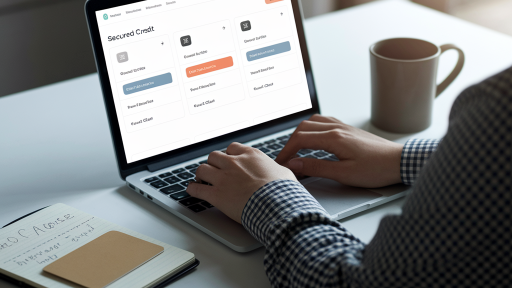In an age where our lives are increasingly digital, online shopping has shifted from a novelty to a daily routine. We buy everything from groceries to gadgets with just a few clicks. But this convenience comes with a hidden risk: every time we enter our credit card details on a new website, we expose our primary financial accounts to potential data breaches and fraud.
This is where a powerful tool for modern consumers comes into play: the virtual online credit card. It’s a simple yet ingenious solution designed to act as a digital shield for your finances. This guide will demystify how they work, explore their significant benefits, and highlight some of the top providers available today, empowering you to transact online with newfound confidence and control.
What Exactly is a Virtual Online Credit Card?
At its core, a virtual online credit card (VCC) is a unique, temporary 16-digit card number, complete with its own expiration date and CVV code, that is generated to mask your real credit or debit card information. Unlike the plastic card in your wallet, a VCC exists only in digital form. It’s created through your bank’s mobile app, website, or a third-party service and is linked to your primary funding account.
Think of it as a digital middleman. When you make a purchase online, you provide the merchant with the virtual card’s details instead of your physical card’s. The charge is approved and processed just like any other transaction, but the merchant never sees or stores your actual account number. This simple separation is a game-changer for online payment security.
Key Differences Between Virtual and Physical Cards
While they both facilitate transactions, virtual and physical cards have distinct characteristics that set them apart. Understanding these differences is key to leveraging their unique advantages.
- Temporality: A physical card is valid for years. A virtual card can be created to expire in a few hours, days, or after a single use, drastically reducing the window of opportunity for fraud.
- Security Layer: If a physical card is compromised, you must cancel it and wait for a new one. If a virtual card number is stolen in a data breach, it’s a minor inconvenience. You can simply delete it and create a new one instantly without affecting your main account.
- Custom Controls: VCCs offer granular control. You can set a specific spending limit on a virtual card (e.g., $15 for a streaming subscription) or lock it to a single merchant, making it useless if stolen and used elsewhere.
- Form Factor: The most obvious difference is their physical presence. One is a tangible piece of plastic, while the other is a set of numbers on your screen, designed exclusively for a digital world.
How Do Virtual Credit Cards Work? The Mechanics Explained
The magic of a virtual credit card lies in its seamless and secure process. The technology works by generating a randomized, tokenized card number that acts as a proxy for your real account. When you’re ready to make an online purchase, you request a virtual number from your provider. This request happens in real-time, delivering the new card details to you in seconds.
This new number is directly linked to your primary credit or debit account, which serves as the funding source. When the virtual number is used to pay for something, the transaction request is routed through the VCC network, which then verifies the details and forwards the charge to your actual account. The charge appears on your statement, often with a note indicating it was made with a virtual number, providing a clear transaction history.
The Step-by-Step Process
Generating and using a virtual card is remarkably straightforward. While the exact steps may vary slightly between providers, the general workflow is consistent and designed for user convenience.
- Access Your Provider: Log in to your bank’s online portal, mobile app, or a dedicated third-party service like Privacy.com.
- Navigate to the VCC Section: Find the option to create or manage virtual cards. This is often found under “Card Services” or “Account Security.”
- Set Your Parameters: This is where you customize the card. You can typically set a maximum spending limit, a specific expiration date, and choose whether the card is for single-use or multiple transactions. Some services also allow you to lock the card to the first merchant it’s used with.
- Generate the Card: With a click of a button, the system instantly generates a new 16-digit number, expiration date, and CVV code.
- Use for Checkout: Simply copy these new details and paste them into the payment fields on the checkout page of the website where you are shopping.
- Transaction Complete: The payment is processed, and the virtual number has done its job. If it was a single-use card, it deactivates automatically. If it’s for a subscription, it remains active until you delete it or it expires.
The Unbeatable Benefits of Using a Virtual Card
The adoption of virtual cards is growing rapidly, and for good reason. They offer a suite of benefits that directly address the most pressing concerns of online consumers, from security to budget management.
Fortified Security Against Breaches
This is the primary advantage. Data breaches are unfortunately common. When a company you’ve shopped with gets hacked, your stored payment information is at risk. If you used a virtual card, the stolen number is either expired, has a zero-dollar limit, or is locked to a different merchant, rendering it completely useless to thieves. Your real account remains untouched and secure.
Complete Control Over Your Spending
Virtual cards are a powerful tool for financial discipline. Are you signing up for a free trial that requires a credit card? Generate a single-use card or one with a $1 limit to prevent “accidental” charges after the trial period ends. You can create a separate virtual card for each of your subscriptions (Netflix, Spotify, etc.) with a limit that matches the exact monthly cost. This prevents overcharging and makes it incredibly easy to “cancel” a service by simply deleting its dedicated virtual card.
Anonymity and Privacy Protection
While not completely anonymous, VCCs add a significant layer of privacy. By masking your real card details, you prevent merchants from linking your purchases back to your primary financial identity. This helps reduce your digital footprint and protects your personal information from being collected and potentially sold by data brokers.
Convenience and Instant Access
There’s no need to wait for a card to arrive in the mail. If you need to make a secure purchase right now, you can generate a virtual card in seconds and use it immediately. This instant accessibility is perfect for time-sensitive purchases or situations where you don’t have your physical wallet on hand but can access your banking app.
Potential Drawbacks and Limitations to Consider
Despite their many advantages, virtual cards are not a perfect solution for every situation. It’s important to be aware of their limitations to know when they are the right tool for the job.
In-Person Purchase Challenges
Virtual cards are designed for “card-not-present” transactions, meaning online or over-the-phone purchases. They lack a magnetic stripe or EMV chip, so you cannot use them at a physical store’s point-of-sale terminal. While some can be added to mobile wallets like Apple Pay or Google Pay, this is not a universally supported feature.
Refunds and Returns Complications
This can be a potential headache. If you return an item purchased with a single-use or expired virtual card, the merchant may have trouble processing the refund. Most modern VCC providers have systems in place to automatically trace the transaction back and credit your source account, but it can sometimes delay the process or require a call to customer service.
Not All Issuers Offer Them
While becoming more common, VCCs are not yet offered by every bank or credit union. You may find that your primary financial institution doesn’t provide this feature, forcing you to rely on third-party providers if you want to take advantage of the technology.
Top Picks: The Best Virtual Online Credit Card Providers
The landscape of VCC providers includes major banks and innovative fintech startups. The best choice for you will depend on your existing financial relationships and specific needs. Here’s a comparison of some of the leading options.
| Provider | Key Feature | Best For | Type |
|---|---|---|---|
| Capital One (Eno) | Browser extension integration | Existing Capital One customers seeking seamless online shopping | Bank-Issued |
| Citi | Available on most consumer credit cards | Citi cardholders who want a reliable, integrated VCC feature | Bank-Issued |
| Privacy.com | Merchant-locking and extensive controls | Users wanting maximum control and flexibility, regardless of their bank | Third-Party |
| Revolut | Disposable single-use cards | Users prioritizing maximum security for one-off purchases | Third-Party |
| Wise (formerly TransferWise) | Multi-currency support and low fees | International shoppers and travelers | Third-Party |
Capital One (Eno)
Eno is Capital One’s intelligent assistant, which offers a slick virtual card experience through a browser extension. When you’re at a checkout page, Eno can pop up and offer to create a merchant-specific virtual card for you, automatically filling in the details. It’s incredibly convenient for existing Capital One credit card holders.
Citi
Citi has been a long-time player in the virtual card space, offering the feature on many of its consumer credit cards. Accessible through your online account, it allows you to generate virtual numbers with custom spending limits and expiration dates, providing a solid, no-frills service for its customers.
Privacy.com
As a third-party provider, Privacy.com links directly to your bank account (not a credit card) and is one of the most feature-rich services available. Its core strengths are the ability to create merchant-locked cards and single-use cards, set spending limits, and pause cards with a single click. Its free tier is robust enough for most users, with paid plans offering additional benefits like cashback.
When Should You Use a Virtual Credit Card? Common Use Cases
The practical applications of VCCs are vast. Integrating them into your online habits can significantly improve both your security and your financial organization.
- Signing Up for Free Trials: This is a classic use case. Use a virtual card with a $1 limit to ensure you’re never billed if you forget to cancel.
- Shopping on Unfamiliar Websites: Found a great deal on a site you’ve never heard of? A single-use virtual card eliminates the risk of sharing your real financial details.
- Managing Subscriptions: Assign a unique, limit-locked virtual card to each recurring payment. This makes your budget clearer and lets you “cancel” a subscription instantly by deleting the card.
- One-Time Purchases: For any single purchase where you don’t want the merchant to “keep your card on file,” a disposable virtual card is the perfect tool.
- Protecting Against Data Breaches: Using a VCC with major retailers means that even if they suffer a massive data breach, your core financial account is insulated from the fallout.
Frequently Asked Questions (FAQ)
Are virtual credit cards safe?
Yes, they are widely considered to be safer than physical cards for online transactions. Because they mask your real account number and can be restricted with limits, expiration dates, or locked to a single merchant, they create multiple layers of protection that a standard credit card lacks.
Do virtual cards affect my credit score?
No, using a virtual card does not directly impact your credit score. The VCC is simply a proxy for your existing credit account. All transactions, payments, and credit utilization are reported to the credit bureaus through your primary account. Responsible use of that underlying account is what affects your score.
Can I get a virtual credit card without a bank account?
Generally, a funding source is required. For bank-issued VCCs, you need an eligible credit card with that bank. For third-party services like Privacy.com, you need to link a checking account. While some prepaid debit cards may offer virtual card numbers, they still require you to load them with funds first.
How do I get a virtual card?
Start by checking with your current credit card provider (like Capital One, Citi, or Bank of America) to see if they offer this feature. If they don’t, you can sign up for a reputable third-party service. The setup process usually involves verifying your identity and linking a funding account, after which you can begin generating cards immediately.
In conclusion, the virtual online credit card is no longer a niche tool for the tech-savvy; it’s an essential component of modern digital hygiene. By providing an unparalleled combination of security, control, and convenience, it empowers you to navigate the world of e-commerce with confidence. Whether you’re safeguarding against data breaches, managing subscriptions more effectively, or simply maintaining your privacy, adopting VCCs is a smart, proactive step toward a more secure financial future.
For more information on protecting yourself during online transactions, you can explore this comprehensive guide to the virtual online credit card and other safe shopping tips from the Federal Trade Commission.




